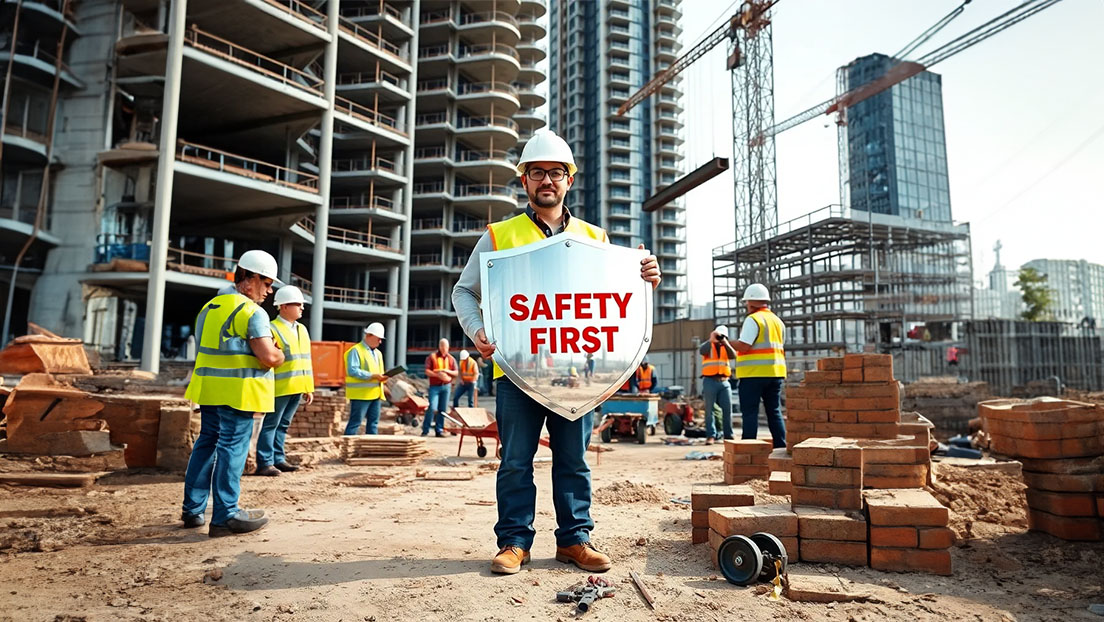GEM Engserv Pvt. Ltd is an ISO 9001:2015 certified organization, certified by TUV India in accreditation with National Accreditation Board for Certification Bodies (NABCB).
GEM Engserv Pvt. Ltd is an ISO 9001:2015 certified organization, certified by TUV India in accreditation with National Accreditation Board for Certification Bodies (NABCB).

The rapidly growing investment in the construction industry has meant that several new players have entered the market recently. While all project owners intend to maintain a robust Safety Management System for their projects, they often do not completely understand how and how much to do in this area. Unfortunately, commercial considerations rather than a scientific approach usually drive this decision, especially for new entrants in the industry.
Since safety management is seen as a cost incurred on the project, our customers often ask about a minimum program for ensuring construction safety. Based on these interactions, we have identified a few of the easiest (read: least expensive) control measures which bring maximum benefit to the state of safety at the construction site.
One of the simplest areas of improvement for every project site is enhancing the culture of safety. This is one of the core responsibilities of the Safety Officer deputed to a project. Engineers and workers retain and focus on aspects that are most commonly talked about. The Safety Officer’s role is to ensure that toolbox talks are conducted daily on relevant topics which are aligned with the area of work that is currently being undertaken.
In addition, the Safety Officer is also responsible for facilitating periodic (weekly) safety training sessions and conducting frequent safety committee meetings in which major deviations and their consequences are discussed.
In general, the Safety Officer needs to be able to project to the execution workforce that no compromise is acceptable when it comes to construction safety. Promoting a culture of safety at the project site, by itself, requires one individual who is technically capable, energetic, observant and is empowered to escalate violations. For larger projects of course, a safety team may be necessary to ensure coverage of crucial functions of safety management.
This is another area which costs next to nothing but can bring tremendous benefit. All it needs is discipline from the Safety Officer as well as the execution team to report and record any incident that occurs on the project site. We can only improve what we measure (record). Therefore, one of responsibilities (and skills) of a Safety Officer is to foster an environment where execution teams, as well as contractors feel comfortable and empowered to report any incidents or near misses.
Further, a careful assessment of incidents over a period of time can generate highly pin-pointed and actionable insights about the areas of improvement. Pareto principle suggests that 80% issues are caused by 20% of the causes and focusing on these 20% areas can significantly lower the risk of a project with respect to safety management.
The labour camp is simultaneously the most ignored area of the project as well as the area which authorities visit first when they are looking for violations. More often than not, living conditions in labour camps are deplorable and the project stakeholders view their welfare as a cost and a nuisance, something that they have to tolerate or look away from. This not only poses a huge risk of accidents but also leads to some second order effects such as low morale and health problems leading to a sub-optimal performance of workers. Some easy wins in this area include ensuring provisions for fire safety, protection against pathogens, infections and wild animals and availability of first aid.
A large proportion of accidents that occur on site are in one way or another related to the use of equipment, machines, tools and tackles. Naturally, controlling and monitoring the equipment used at the project is linked to safety. Each machine’s specification is defined to include parameters of safe operations. This needs to be monitored periodically in order to ensure zero failure or deviation from performance parameters.
Each equipment, machine, tools and tackles have a specified frequency as per which it needs to be inspected. There are also very specific checks that need to be performed for each equipment (as per the project safety plan). Once again, the key stakeholder involved here is the Safety Officer who is responsible for ensuring that each equipment is inspected in compliance with the defined inspection frequency. Aside from any special testing requirements (if any), this does not entail any other cost, apart from the Safety Officer’s personnel cost.
Housekeeping is one of the low hanging fruits from a project safety as well as productivity perspective. Maintaining a clean and organized working environment not only prevents trips and falls (which is a natural outcome), but also simplifies movement of men, material and machine. Another highly overlooked benefit of good housekeeping is an improved traceability of inventory and reduced chances of theft and pilferage. Here, we are not even considering some of the more subjective benefits such as the positive impact on the attitude of workers engaged in daily activities and the morale of the construction team at the end of their work-shift.
Several project teams schedule a 15-minute housekeeping drill at the end of each shift as a matter of habit that ensures that they handover a clean facility to the team members working in the next shift. Another effective practice is to setup a reward and recognition scheme for gangs of workers who operate at the highest standard of housekeeping. In all likelihood, this is the team that is delivering the best productivity at the construction site.
Moving up in the hierarchy of safety management system is not always about using expensive equipment and implementing complex processes that cost big money. It is usually a back-to-basics approach and a humanitarian, empathetic outlook towards our workforce that brings maximum benefit.
GEM Engserv Private Ltd. , A-103, The Great Eastern Chamber, Plot No-28, Sector-11, CBD Belapur, Navi Mumbai 400614